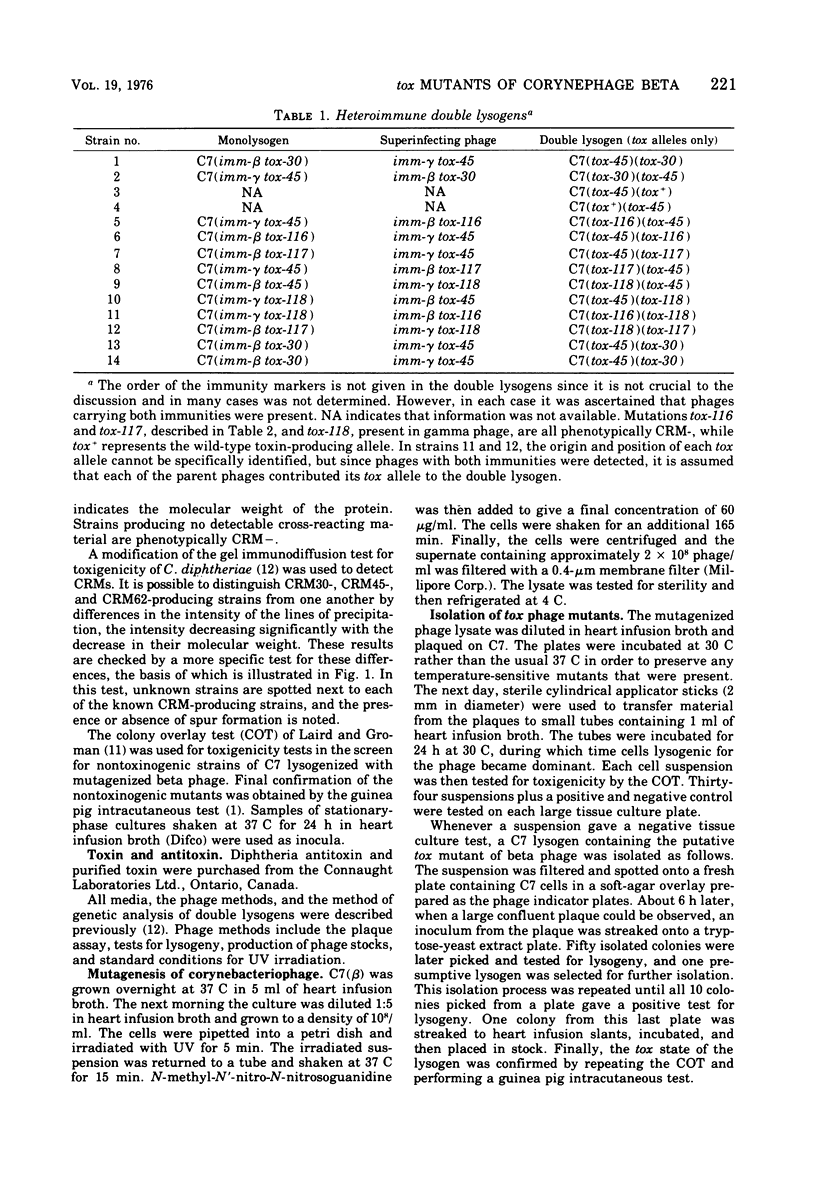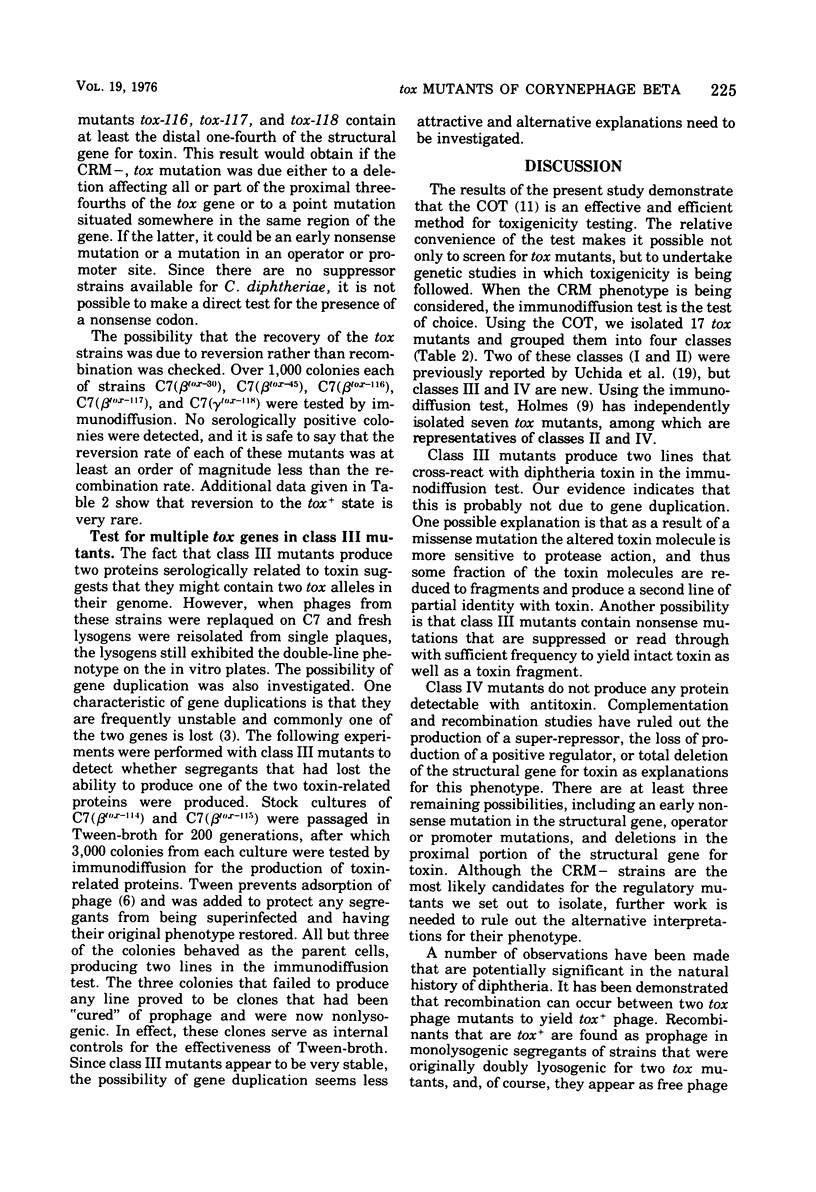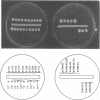Abstract
Seventeen nontoxinogenic (tox) mutants of corynebacteriophage beta have been isolated by using a tissue culture screening technique. The mutants fall into four major classes. Two of the classes, I and II, appear to contain missense and nonsense mutants, respectively. However, classes III and IV have not been previously described. Class III mutants produce two proteins (CRMs) seriologically related to diphtheria toxin, but efforts to demonstrate the presence of more than one tox gene have been successful. Class IV mutants are phenotypically CRM-, failing to produce any detectable protein serologically related to diphtheria toxin. Genetic studies indicate that the mutations in class IV strains are not in a gene distinct form the structural gene for toxin, and that the CRM- strains retain at least a portion of that gene. A natural phage isolate, gamma, behaves in a completely parallel fashion to the class IV mutants. The production of tox+ recombinants through recombination of various pairs of tox phage mutants has been demonstrated. The implications of these findings for the natural history of diphtheria are discussed.
Full text
PDF







Images in this article
Selected References
These references are in PubMed. This may not be the complete list of references from this article.
- Barksdale L. I. : Lysogenic Conversions in Bacteria. Bacteriol Rev. 1959 Dec;23(4):202–212. doi: 10.1128/br.23.4.202-212.1959. [DOI] [PMC free article] [PubMed] [Google Scholar]
- Bertani G., Bertani L. E. Constitutive expression of bacteriophage P2 early genes resulting from a tandem duplication. Proc Natl Acad Sci U S A. 1974 Feb;71(2):315–319. doi: 10.1073/pnas.71.2.315. [DOI] [PMC free article] [PubMed] [Google Scholar]
- FREEMAN V. J. Studies on the virulence of bacteriophage-infected strains of Corynebacterium diphtheriae. J Bacteriol. 1951 Jun;61(6):675–688. doi: 10.1128/jb.61.6.675-688.1951. [DOI] [PMC free article] [PubMed] [Google Scholar]
- GROMAN N. B., BOBB D. The inhibition of adsorption of Corynebacterium diphtheriae phage by tween 80. Virology. 1955 Sep;1(3):313–323. doi: 10.1016/0042-6822(55)90027-1. [DOI] [PubMed] [Google Scholar]
- GROMAN N. B. Conversion in Corynebacterium diphtheriae with phages originating from nontoxigenic strains. Virology. 1956 Dec;2(6):843–844. doi: 10.1016/0042-6822(56)90066-6. [DOI] [PubMed] [Google Scholar]
- GROMAN N. B., EATON M. Genetic factors in Corynebacterium diphtheriae conversion. J Bacteriol. 1955 Dec;70(6):637–640. doi: 10.1128/jb.70.6.637-640.1955. [DOI] [PMC free article] [PubMed] [Google Scholar]
- GROMAN N. B., MEMMER R. Lysogeny and conversion in mitis and mitis-like Corynebacterium diphtheriae. J Gen Microbiol. 1958 Dec;19(3):634–644. doi: 10.1099/00221287-19-3-634. [DOI] [PubMed] [Google Scholar]
- Holmes R. K. Characterization and genetic mapping of nontoxinogenic (tox) mutants of corynebacteriophage beta. J Virol. 1976 Jul;19(1):195–207. doi: 10.1128/jvi.19.1.195-207.1976. [DOI] [PMC free article] [PubMed] [Google Scholar]
- Holmes R. K., Perlow R. B. Quantitative assay of diphtherial toxin and of immunologically cross-reacting proteins by reversed passive hemagglutination. Infect Immun. 1975 Dec;12(6):1392–1400. doi: 10.1128/iai.12.6.1392-1400.1975. [DOI] [PMC free article] [PubMed] [Google Scholar]
- Laird W., Groman N. Prophage map of converting corynebacteriophage beta. J Virol. 1976 Jul;19(1):208–219. doi: 10.1128/jvi.19.1.208-219.1976. [DOI] [PMC free article] [PubMed] [Google Scholar]
- Laird W., Groman N. Rapid, direct tissue culture test for toxigenicity of Corynebacterium diphtheriae. Appl Microbiol. 1973 May;25(5):709–712. doi: 10.1128/am.25.5.709-712.1973. [DOI] [PMC free article] [PubMed] [Google Scholar]
- Murphy J. R., Pappenheimer A. M., Jr, de Borms S. T. Synthesis of diphtheria tox-gene products in Escherichia coli extracts. Proc Natl Acad Sci U S A. 1974 Jan;71(1):11–15. doi: 10.1073/pnas.71.1.11. [DOI] [PMC free article] [PubMed] [Google Scholar]
- PARSONS E. I. Induction of toxigenicity in non-toxigenic strains of C. diphtheriae with bacteriophages derived from non-toxigenic strains. Proc Soc Exp Biol Med. 1955 Oct;90(1):91–93. doi: 10.3181/00379727-90-21948. [DOI] [PubMed] [Google Scholar]
- Pappenheimer A. M., Jr, Uchida T., Harper A. A. An immunological study of the diphtheria toxin molecule. Immunochemistry. 1972 Sep;9(9):891–906. doi: 10.1016/0019-2791(72)90163-2. [DOI] [PubMed] [Google Scholar]
- Uchida T., Pappenheimer A. M., Jr, Greany R. Diphtheria toxin and related proteins. I. Isolation and properties of mutant proteins serologically related to diphtheria toxin. J Biol Chem. 1973 Jun 10;248(11):3838–3844. [PubMed] [Google Scholar]
- Weber K., Osborn M. The reliability of molecular weight determinations by dodecyl sulfate-polyacrylamide gel electrophoresis. J Biol Chem. 1969 Aug 25;244(16):4406–4412. [PubMed] [Google Scholar]



